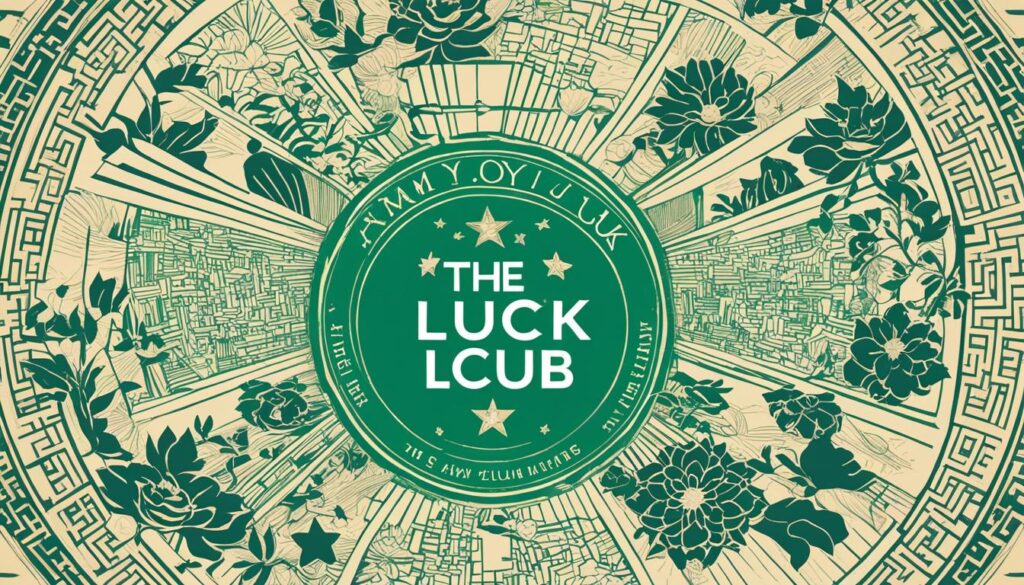In this section, we will provide a comprehensive audiobook review of “The Joy Luck Club” by Amy Tan. Published in 1989, this novel explores the immigrant experience and the complexities of mother-daughter relationships. Our review will examine the impact of the audiobook as a gripping tale of heritage and bonding. Whether you’re a long-time fan of Amy Tan or a newcomer to her work, this audiobook review is sure to provide insight into this classic novel.
Introduction to “The Joy Luck Club”
Published in 1989, “The Joy Luck Club” is a novel written by Amy Tan. The book is a poignant portrayal of the immigrant experience and explores the complexities of mother-daughter relationships.
The novel follows the lives of four Chinese American women and their four American-born daughters as they strive to find meaning and purpose in their lives. Tan’s vivid descriptions of cultural differences and clashes provide a thought-provoking exploration of identity and familial ties.
The novel has been widely acclaimed for its exploration of the Asian American experience and its focus on the strength and resilience of women. It has been adapted into a successful movie and audiobook, which we will explore in more detail in later sections of our review.
Overall, “The Joy Luck Club” is a moving and thought-provoking novel that explores the complexities of the immigrant experience and mother-daughter relationships.
Background of Amy Tan
Amy Tan is a Chinese-American author who was born in Oakland, California, in 1952. Despite her parents’ hopes that she would become a doctor or concert pianist, Tan pursued a career in writing, studying English and linguistics in college.
After a successful career in freelance writing, Tan published her debut novel, “The Joy Luck Club,” in 1989. The novel was an immediate success, earning critical acclaim and becoming a bestseller. Since then, Tan has authored several other bestselling novels, including “The Kitchen God’s Wife,” “The Bonesetter’s Daughter,” and “The Valley of Amazement.”
Tan’s writing often explores themes of Chinese-American identity, family relationships, and the immigrant experience. Her storytelling is characterized by vivid imagery and symbolism, which have made her a beloved and influential voice in American literature.
In addition to her writing, Tan has been actively involved in promoting literacy and supporting programs that help immigrant children. She has received numerous accolades throughout her career, including the National Endowment for the Arts Fellowship and the Guggenheim Fellowship for Creative Arts. Today, Amy Tan continues to be a celebrated author and advocate for cultural understanding and representation in literature.
Plot Summary of “The Joy Luck Club”
In “The Joy Luck Club,” author Amy Tan weaves a complex narrative that follows the lives of four Chinese immigrant women and their American-born daughters. The novel is structured around sixteen interconnected stories, with each chapter alternating between the perspectives of the mothers and daughters. Overall, the plot explores the cultural clashes and misunderstood intentions that occur between the generations.
The narrative begins with the mothers’ stories, which take place in China before their emigration to the United States. Each woman has endured incredible hardships and struggles so that their daughters could have a better life. These stories are gracefully intertwined with those of their daughters, who narrate their lives in America and reveal the impact of their mother’s experiences on their own identities.
The Joy Luck Club plot navigates through the complexities of the mother-daughter bond, cultural identity, and generational conflict, intersecting in moments of joy and sorrow. The key events include Jing-mei’s trip to China to reconnect with her half-sisters, Lena’s marriage struggles, Waverly’s ongoing power struggles with her mother, and An-mei’s reunion with her long-lost daughter. The novel has a compelling narrative structure that deeply immerses readers into the intricacies of family relationships and the immigrant experience.
“The Joy Luck Club’s plot is not only a beautiful depiction of the Chinese immigrant experience, but it also reveals the universal human desire for love, understanding, and connection within families and across generations.”
Characters in “The Joy Luck Club”
“The Joy Luck Club” presents a diverse cast of characters, each with a unique story and perspective shaped by their immigrant experiences. The novel centers around four Chinese immigrant mothers and their American-born daughters, exploring the complexities of the mother-daughter relationships and cultural identity.
The protagonists are:
| Character | Description |
|---|---|
| Jing-mei “June” Woo | The youngest of the daughters, struggling to come to terms with her Chinese heritage while embracing her American identity. |
| Lindo Jong | A strong-willed mother who is determined to keep her daughter Waverly from suffering the same fate as she did in China. |
| An-mei Hsu | A devout Christian who experiences a crisis of faith after witnessing her mother’s traumatic suicide. |
| Ying-ying St. Clair | A quiet and demure mother with a hidden strength and a traumatic past that she must confront. |
The relationships between these mothers and daughters are further explored through the development of the following additional characters:
- Suyuan Woo – Jing-mei’s deceased mother, whose memory and legacy drives much of the novel’s plot.
- Rose Hsu Jordan – An-mei’s daughter, who struggles to assert herself in her failing marriage.
- Waverly Jong – Lindo’s daughter and a talented chess player, whose success becomes a source of tension between her and her mother.
- Lena St. Clair – Ying-ying’s daughter, whose strict adherence to logic clashes with her mother’s focus on intuition and unseen forces.
The characters in “The Joy Luck Club” are richly developed and each contributes to the novel’s exploration of immigrant experiences and the complexities of mother-daughter relationships. Their unique perspectives and experiences are powerfully conveyed through Tan’s vivid imagery and narrative style.
Setting of “The Joy Luck Club”
The setting of “The Joy Luck Club” is divided between San Francisco and China, showcasing the cultural clash between the East and West. The novel is set in both contemporary times and various periods in the past, exploring the heritage of the Chinese immigrant mothers and their American-born daughters.
The juxtaposition of San Francisco and China highlights the differences in customs, values, and beliefs between the two cultures. For instance, the mothers’ struggles with their traditional Chinese values in the modern American society are depicted through the characters’ experiences.

Through the use of vivid imagery and detailed descriptions, author Amy Tan transports the reader to the vibrant streets of San Francisco’s Chinatown and the rural villages of China. The setting creates a sense of nostalgia, longing, and displacement, evoking the immigrant experience and the complexity of cultural identity.
San Francisco
San Francisco is the primary setting of the novel and serves as a backdrop to the lives of the characters. The bustling city represents the opportunities and challenges of the American Dream, contrasting with the traditions and values of the Chinese culture.
China
China is depicted as a land of memories, dreams, and secrets. The characters’ past lives in China are interwoven with the present events, revealing the generational conflict and the struggles of maintaining cultural identity while adapting to a new way of life.
In conclusion, the setting of “The Joy Luck Club” adds depth and meaning to the novel, exploring the cultural clash and identity crisis faced by the characters. Amy Tan’s writing transports the reader to the contrasting locations of San Francisco and China, evoking a sense of nostalgia and displacement.
Themes in “The Joy Luck Club”
Amy Tan’s “The Joy Luck Club” is renowned for its exploration of a variety of themes, including cultural identity, generational conflict, and mother-daughter relationships.
Cultural Identity
Set against a backdrop of Chinese culture and the immigrant experience, “The Joy Luck Club” delves deep into the theme of cultural identity. The characters are torn between two distinct cultures, with their sense of identity influenced by their upbringing and the traditions of their ancestors. Through the exploration of cultural identity, Tan offers insights into the complexities of cultural assimilation and the importance of heritage.
Generational Conflict
“The Joy Luck Club” centers around the relationships between mothers and daughters, with generational conflict being another prominent theme. The older generation of mothers often struggle to communicate and connect with their American-born daughters, leading to misunderstandings and tension. Tan explores the challenges faced by both generations and the importance of understanding and empathy in bridging the communication gap.
Mother-Daughter Relationships
The intricacies of mother-daughter relationships are a central theme in “The Joy Luck Club.” The novel paints a rich and complex portrait of the relationships between mothers and daughters, exploring the unique bond and love that exists between them. Tan’s exploration of this theme highlights the importance of communication and understanding within families, and the power of forgiveness and empathy in healing fractured relationships.
Writing Style of Amy Tan
Amy Tan’s writing style in “The Joy Luck Club” is characterized by her skillful use of narrative techniques, vivid imagery, and symbolism.
Tan’s use of multiple narrators and non-linear storytelling adds depth and complexity to the novel’s exploration of mother-daughter relationships and the immigrant experience. Through her use of vivid imagery, Tan transports the reader to the contrasting locations of San Francisco and China, and immerses them in the intricacies of her characters’ lives.
Symbolism is another key aspect of Tan’s writing style in “The Joy Luck Club.” From the “swan feather” to the “scarred tree,” each symbol serves as a powerful representation of the characters’ cultural identity, generational conflicts, and emotional struggles.
Overall, Tan’s masterful writing style elevates “The Joy Luck Club” to a poignant and unforgettable piece of literature.
Symbolism in “The Joy Luck Club”
| Symbol | Meaning |
|---|---|
| Swan feather | Represents the hope for transformation and beauty |
| Scarred tree | Symbolizes the pain and emotional trauma of the past |
| Mahjong tiles | Represent the complex relationship between the mothers and daughters |
Audiobook Narration
The audiobook version of “The Joy Luck Club” features masterful narration by a team of skilled voice actors. The performance is a standout feature, with each character brought to life through distinctive tones and inflections. The pacing of the narration enhances the gripping nature of the novel, drawing the listener in and keeping them invested in the story.
The voice actors skillfully convey the emotions of each character, adding depth and nuance to their performances. From the warmth of a mother’s voice to the innocence of a child’s, the narration captures the essence of the novel’s rich characters.
“The narration of ‘The Joy Luck Club’ audiobook gave me a whole new appreciation for the emotional depth of the novel. The voice actors truly brought the story to life.” – Emily, audiobook listener
Audiobook Listening Experience
Listening to “The Joy Luck Club” on audiobook is an immersive experience that brings the story to life in a new way. The narration by actress Gwendoline Yeo captures the rhythm and tone of the prose, adding depth and emotion to the already powerful tale.
One of the benefits of the audiobook format is the ability to fully immerse oneself in the story without the distractions of the outside world. As the listener becomes fully absorbed in the narrative, they are likely to feel a greater emotional impact than when reading the text on the page.
The accessibility of audiobooks also makes them an excellent choice for those who prefer to listen rather than read due to visual impairments or other disabilities. “The Joy Luck Club” audiobook is a great example of how stories can become more accessible through this format.
Reception and Reviews
“The Joy Luck Club” has received critical acclaim since its original publication in 1989, and the audiobook version has not fallen short. The audiobook has been praised for its vivid storytelling, emotional depth, and superb narration.
Critics have described the audiobook as an immersive experience, with the voice actors bringing the characters to life in a powerful and nuanced way. Many have also appreciated the accessibility of the audio format, making it an excellent option for those with visual impairments or those who prefer to listen instead of reading.
The audiobook has received multiple accolades, including the Audiofile Earphones Award and the Audie Award for Best Audio Drama.
“This audiobook is a moving and unforgettable experience. The narration is simply amazing, and the emotional impact of the story is profound.” – Goodreads review
Reader feedback on the audiobook has also been overwhelmingly positive, with many noting its ability to elicit strong emotions and provide a captivating listening experience.
| Pros | Cons |
|---|---|
| Superb narration | None reported |
| Emotionally gripping | |
| Accessible format | |
| Excellent production value |
Overall, the critical reception and reader feedback for “The Joy Luck Club” audiobook have been overwhelmingly positive, cementing its status as a truly compelling and engaging listening experience.

Cultural Impact of “The Joy Luck Club”
Published in 1989, “The Joy Luck Club” by Amy Tan has had a significant cultural impact, particularly in the portrayal and representation of Asian-Americans in literature. The novel’s exploration of the immigrant experience and mother-daughter relationships resonated with readers of all backgrounds and shed light on a previously taboo subject.
The success of “The Joy Luck Club” led to an increased interest in Asian-American representation, both in literature and popular culture. The book’s adaptation into a successful film further cemented its impact and brought the story to a wider audience.
Moreover, the literary significance of “The Joy Luck Club” is undeniable. Tan’s vivid and poignant portrayal of the immigrant experience contributed to a greater understanding and appreciation of cultural diversity in literature. The novel’s themes of generational conflict and the complexity of mother-daughter relationships continue to resonate with readers today, cementing its status as a timeless classic of contemporary literature.
Comparison to the Novel
Both the audiobook and book versions of “The Joy Luck Club” have their advantages and disadvantages.
The audiobook provides a captivating listening experience, with voice actors expertly conveying the emotions and nuances of the characters. Additionally, the audiobook format makes the story more accessible to those with visual impairments or who are unable to read for extended periods of time.
On the other hand, the book offers the advantage of being able to easily reference previous sections or skip ahead to specific passages. Readers may also prefer the experience of interpreting the visual descriptions for themselves, rather than having everything dictated to them through the audiobook.
Ultimately, the format that readers prefer will depend on their personal preferences and circumstances. Those who enjoy audiobooks may find the production of “The Joy Luck Club” to be a rewarding and engaging experience, while avid readers may prefer the detail and control offered by the physical book.
Recommendations for Readers
If you enjoyed “The Joy Luck Club” and want to explore more of Amy Tan’s works, we recommend checking out:
| Title | Publication Date |
|---|---|
| The Kitchen God’s Wife | 1991 |
| The Hundred Secret Senses | 1995 |
| The Bonesetter’s Daughter | 2001 |
These novels share similar themes of cultural identity, family dynamics, and immigration experiences, and are sure to captivate fans of “The Joy Luck Club.”
In addition, “The Joy Luck Club” is an excellent choice for book clubs, as it offers plenty of opportunities for in-depth discussions on cultural differences, mother-daughter relationships, and the immigrant experience. We recommend adding it to your book club reading list.
Additional Works by Amy Tan
If you enjoyed “The Joy Luck Club,” we recommend checking out Amy Tan’s other notable novels to further explore her writing style and themes. Some of her additional works include:
| Title | Publication Date |
|---|---|
| The Kitchen God’s Wife | 1991 |
| The Hundred Secret Senses | 1995 |
| The Bonesetter’s Daughter | 2001 |
Each of these novels explores similar themes of identity, family, and cultural clashes, and offers a compelling read for fans of “The Joy Luck Club.” Whether you’re looking for a new audiobook to listen to or a novel for your book club, Amy Tan’s works are sure to satisfy.
Conclusion
Overall, the audiobook version of “The Joy Luck Club” by Amy Tan offers a compelling listening experience for those interested in exploring themes of culture, family dynamics, and immigration. The audiobook narration is solid, with voice actors bringing the various characters to life and maintaining a steady pace throughout the production.
Amy Tan’s masterful writing style shines through in the audiobook format, with vivid imagery and symbolism enhancing the storytelling and immersing the listener in the world of the characters. The audiobook also offers accessibility for those who may have difficulty with reading print, making it a valuable alternative to the physical book for some readers.
Our final thoughts on the audiobook review of “The Joy Luck Club” are that it is a must-listen for fans of Amy Tan’s work or those interested in Asian-American literature. The audiobook format adds a new dimension to the novel, bringing the characters to life in a way that may not be achieved through reading alone. We highly recommend this audiobook for both personal enjoyment and as a valuable addition to book club discussions.



